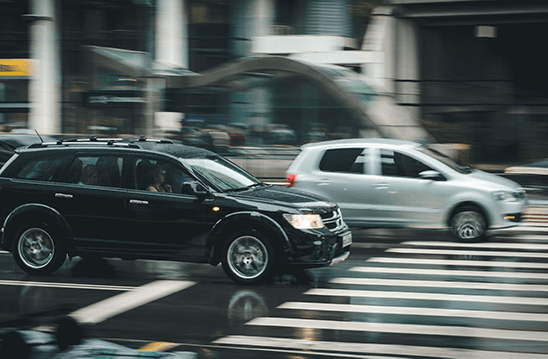 After a Passenger Vehicle or Heavy Truck crash occurs, one of the first priorities of investigators is to try to determine the speed the involved vehicles were traveling at. This piece of information can help shed light on who was at fault and what the exact series of events were that led to the collision. The speed at which an accident occurs has a significant impact on the severity of injuries to those affected as well as the amount of damage to the involved vehicles. An accident reconstruction expert will look at all available information: Black Box Downloads, Skid Marks, Injuries Sustained, as well as the damage incurred by the vehicles.
After a Passenger Vehicle or Heavy Truck crash occurs, one of the first priorities of investigators is to try to determine the speed the involved vehicles were traveling at. This piece of information can help shed light on who was at fault and what the exact series of events were that led to the collision. The speed at which an accident occurs has a significant impact on the severity of injuries to those affected as well as the amount of damage to the involved vehicles. An accident reconstruction expert will look at all available information: Black Box Downloads, Skid Marks, Injuries Sustained, as well as the damage incurred by the vehicles.
Low-Speed Collisions
A collision is generally considered low-speed if it occurs at speeds of 10 miles per hour or less. A crash at this speed, commonly referred to as a fender bender, frequently arises from rear-end collisions at intersections and parking lots. These accidents are usually classified as minor, but there can still be costly damage to the vehicles involved, including scratches and dents to bumpers or other impact zones and damage to headlights, taillights, or the grille. It is less likely for there to be injuries at this speed, but still possible - especially to the neck of anyone rear-ended at a complete stop. Sometimes in low-speed accidents, the vehicle’s black box may not record any crash data if the impact is not significant.
Mid-Speed Collisions
Mid-speed collisions generally occur at speeds of 10 to 30 miles per hour and can cause significant damage to any vehicles involved. These moderate accidents can cause damage to the front, rear, and sides, depending on where the two cars impacted. The impact can also cause damage to the frame of the vehicle, which can lead to structural damage that may affect the safety of the vehicle.
High-Speed Collisions
A high-speed collision is one which occurs at speeds above 30 miles per hour. A crash at this speed would be considered a severe accident and almost inevitably causes extensive damage to the vehicles involved. A vehicle involved in a collision at this speed may very well be totaled, and passengers are at a much greater risk for injury. The impact can sometimes cause the engine to be pushed into the driver and passenger, causing serious injury.
Factors Affecting Car Damage
Speed is one of the most critical factors that affect the damage a vehicle incurs, but there are many other factors to consider.
A significant weight disparity between involved vehicles can be catastrophic for the smaller sized vehicle, as huge vehicles like semi trucks can weigh upwards of 80,000 lbs, while the average passenger car weighs around 4,000 lbs. A semi-truck weighing 20 times the smaller car will bring that much more force to the impact.
Another consideration is the angle of impact. Vehicles are designed to protect the occupants during collisions from all sides, but there are still points on a vehicle that would be likely to cause more harm if impacted. A side impact would have less protection than a front impact due to the bumper and airbags.
An additional consideration is the age and condition of the vehicle. A very old car may have been built before the development of the "crumple zone", which helps transfer kinetic energy from the crash into the vehicle instead of the vehicle's occupants. The crumple zone is a powerful safety feature and means that older cars may take on less damage but more force is transferred inside to the occupants, leading to worse injury outcomes.
Fortunately, according to the National Highway Traffic Safety Administration, "Vehicle safety has changed drastically over the years, and today newer cars are safer than ever before. Thanks to advanced engineering, in-depth research, and analysis of crash data, newer vehicles are built better and have more safety features to protect you."
Car crashes can lead to severe injuries, fatalities, and extensive damage to the vehicles involved. The speed at which the involved vehicles are traveling is one of the most critical factors contributing to both vehicle damage and human injury, however, there are additional factors to consider. When an Accident Reconstruction expert is tasked with analyzing what led to a crash, they will look closely at the damage incurred by the vehicle to help determine the speed at which the vehicle was traveling and what series of events led to the collision.


